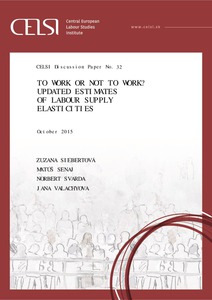To work or not to work? Updated estimates of labour supply elasticities
"This paper provides a revised microeconometric analysis of extensive margin labour supply elasticities in Slovakia. Compared to earlier analysis, we estimate the elasticities for males and females separately. We find that a one percent increase in net wage increases the probability of economic...
| Main Authors: | , , , |
|---|---|
| Institution: | ETUI-European Trade Union Institute |
| Format: | TEXT |
| Language: | English |
| Published: |
Bratislava
2015
CELSI |
| Subjects: | |
| Online Access: | https://www.labourline.org/KENTIKA-19109838124919270109-To-work-or-not-to-work?-update.htm |
| Summary: | "This paper provides a revised microeconometric analysis of extensive margin labour supply elasticities in Slovakia. Compared to earlier analysis, we estimate the elasticities for males and females separately. We find that a one percent increase in net wage increases the probability of economic activity by 0.21 and 0.4 percentage points for males and females, respectively. Taking into account tax and transfer system details valid in Slovakia in 2009-2012, a one percent increase in transfers decreases the semi-elasticity of labour force participation by 0.03 percentage points for males and 0.05 percentage points for females. These results are broadly in line with the elasticities usually reported in the literature. Our results show that low-skilled, females and the elderly are the groups that are particularly responsive to changes in taxes and transfers. Labour market policies aimed to boost employment should concentrate on increasing marginal gains to work, especially for low-educated individuals and women." |
|---|---|
| Physical Description: | 26 p. Digital |

